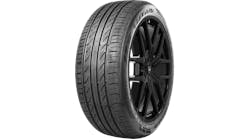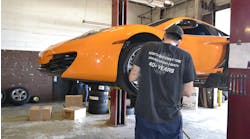Movistar Yamaha MotoGP’s Valentino Rossi won a dramatic Australian Grand Prix last Sunday, leading a Yamaha sweep of the podium in a race where rapidly cooling temperatures created challenging conditions for the riders.
After a warm start to the day, a cool change in the afternoon saw cool winds lower ambient and track temperatures for the race, with the peak track temperature recording of 34°C recorded at the start of the twenty-seven lap race. This year’s Australian Grand Prix saw Bridgestone bring a whole new range of asymmetric rear slick tires to meet the severe demands of the recently repaved Phillip Island circuit, as well as a newly-developed asymmetric front slick – the first time Bridgestone has offered this technology to MotoGP riders.
Q&A with Shinji Aoki – Manager, Bridgestone Motorcycle tire Development Department
Much like the last round at Motegi, temperatures for Sunday’s race were much cooler than compared to the previous day. How much of an effect did this have on tire choice for the race, and tire performance?
“The change in the weather at Phillip Island was much more pronounced than what happened at Motegi the previous weekend. A change late in the afternoon caused a dramatic drop in ambient temperatures, and also the wind strengthened and cooled down – these two factors combined to create very challenging conditions. This change didn’t have a big effect on rear tire choice as already most riders had already opted for the softer rear slick options, but for the front tire some riders did change from their original choice of the soft compound front slicks and swapped to the extra-soft compound front slick.
“The cool and breezy conditions definitely increased the challenge of racing at Phillip Island which has the highest average speed on the MotoGP calendar. tire performance throughout the twenty-seven laps of the race was very consistent, but unfortunately in the final stages there were a few incidents. The double cooling effect of low ambient temperatures and cool winds have often created challenging conditions in the past at Phillip Island, and last Sunday was another example of how quickly things can change at the Australian Grand Prix.”
After last year’s Australian Grand Prix, all three rear slick options brought to Phillip Island last weekend were completely new. Are you happy with how these options performed?
“Our target for our rear tire allocation for this year’s Australian Grand Prix was to provide tires that could provide full race distance durability with consistent performance. This target wasn’t easy to achieve given how harsh the Phillip Island track proved to be on rear tires last year, but through a vigorous testing and development program we could engineer a completely new generation of rear tires for this year’s race to achieve this goal. It was important that these new tires would last the whole race, yet provide predictable grip throughout their life and I believe we met this target. We achieved this by utilizing a new range of compounds for the rear slicks, as well as a new construction which we will only use at Phillip Island. Overall I am really happy how our rear tires performed in Australia, as all weekend the pace among the front runners was extremely competitive, with Ducati, Honda and Yamaha all closely matched. The pace throughout the whole race was quick and consistent and durability exceeded our expectations.”
Bridgestone introduced an asymmetric front slick at Phillip Island. Was this option used and what was the feedback from the riders?
“The rider feedback and data we collected on our new asymmetric front slick shows this new tire meets our development goal; namely, the same braking feel as a conventional tire but better grip and warm-up performance on its softer shoulder, which at Phillip Island was the right shoulder. The riders that used this tire got good braking feel and importantly, didn’t feel any difference when transitioning between the zones of different rubber hardness. The fact that most of the riders selected this option for the race reflects just how good they felt riding it. What was evident during the race was that with the cool change that occurred, the riders on our softest front slick, the extra-soft option, fared better at the end of the race than those on the soft compound asymmetric front slick, but this was due to this softest slick option working better in extremely cool conditions, rather than being a shortfall of the asymmetric design. Overall, the design of our asymmetric front slick has given riders something they are quite happy with and we will continue to offer asymmetric front slicks in the future, including having a tire of this type in our allocation for the last race of the year at Valencia.”


